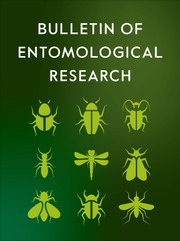No CrossRef data available.
Article contents
Potential distribution prediction of two destructive rice weevils in China based on an ensemble model
Published online by Cambridge University Press: 07 October 2025
Abstract
Rice water weevils (RWWs) (Lissorhoptrus oryzophilus) and rice weevils (RW) (Echinocnemus squameus) (both Coleoptera: Curculionidae) are major rice pests that cause significant economic losses in China. Understanding their potential distribution areas is crucial for effective management. This study used the Biomod2 package in R to simulate and predict the current and future potential distributions, changes in suitable areas, shifts in distribution centres, and overlaps under climate change for both pests under three greenhouse gas emission scenarios. By 2023, the suitable areas for RWWs and RWs were 538.52 × 104 km2 and 376.05 × 104 km2, respectively. The suitable area for the former pest expanded southwestward and northeastward across China, whereas the latter spread mainly into Northeast China. The suitable area for RWWs is projected to remain stable, whereas that for RWs is expected to decline. The distribution centroid of RWWs is anticipated to shift toward southeastern or southwestern Shaanxi, whereas RWs are likely to migrate toward central-eastern or northeastern Shaanxi. The niche overlap between the two pests is high (Schoener’s D = 0.658, I = 0.816), with overlap concentrated in central, eastern, and southern China. The key factors influencing their distributions include precipitation of the wettest month (Bio13), mean temperature of the warmest quarter (Bio10), and precipitation of the driest month (Bio14). This study provides a theoretical basis for the prediction of the potential distribution of both pests, which offers valuable insights for the development of effective pest control strategies in China.
Keywords
Information
- Type
- Review Article
- Information
- Copyright
- © The Author(s), 2025. Published by Cambridge University Press.


